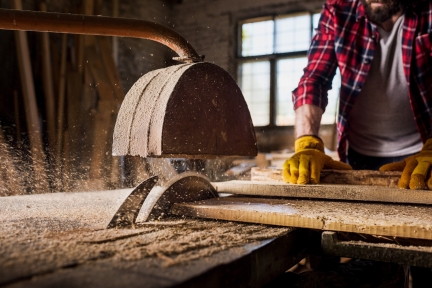
Air emissions
State permits
Airborne dust is a nuisance and a health concern. Woodworking businesses — from sawmills to wood-product manufacturers — can create dust from manufacturing processes, outdoor stockpiles, and hauling and transferring material. The MPCA requires facilities to prevent dust from becoming airborne.
Air permit. Whether you need an air permit will depend on your various processes and their potential to create air emissions. The very smallest facilities may qualify as insignificant facilities, which do not need a permit.
A woodworking facility can use this calculator to see if they may qualify to operate without an air permit by following certain technical standards:
Use these process-focused calculators to determine your facility's potential and actual emissions.
- If you fuel a boiler:
- Engines or backup generator:
- If you finish wood with paint, stains and solvents:
Complying with state permits
Air permit due dates
| Requirement | Due date |
|---|---|
| Emission inventory fee for previous reporting year | Mailed to permit holders between February and April, due within 30 days |
| Emission inventory report | April 1 |
| Emissions summary review period | Begins in August/September |
Federal permits
Whether or not your business has an air permit, you may need to meet the requirements of National Emission Standards for Hazardous Air Pollutants (NESHAP:
- Wood Furniture Manufacturing Operations (2J) NESHAP focuses on hazardous air pollutants in coating, gluing, cleaning, and wash off materials. If this federal air standard applies to your business, you must create:
- The Paint Stripping and Miscellaneous Surface Coating Operations (6H) NESHAP affects facilities that spray paint onto metal, wood, or plastic or use methylene chloride to remove paint. Paints and solvents contain VOCs and hazardous air pollutants.
| If this standard applies, submit | Due date |
|---|---|
| 180 days after startup |
- Review the list of other federal air standards for businesses using solvents, paints, and stains.
Hazardous waste
You need a hazardous waste identification number if your business produces any amount of hazardous waste.
Businesses generating most types of hazardous waste are required to report annually, pay a fee, and obtain a license for the subsequent year. Facilities in Anoka, Carver, Dakota, Hennepin, Ramsey, Scott, or Washington County are licensed and inspected by their county. Facilities in greater Minnesota are licensed and inspected by the MPCA. If you produce only small amounts of hazardous waste, you probably qualify as a very small quality generator:
Annual hazardous waste training is required for businesses that generate 220 pounds or more of hazardous waste a month. Learn more: Hazardous waste
Hazardous waste due dates
| Requirement | Due date |
|---|---|
| Hazardous waste generators fee | Mailed to license holders in first quarter, due date on invoice |
| License application | Due August 15 for Greater Minnesota businesses; Twin Cities metro businesses, contact your county |
Stormwater
Apply for an industrial stormwater permit if you have material, equipment, or activities that are exposed to rain, snow, or runoff. You may qualify for the no-cost no-exposure certification and avoid the permit and fees if you don’t have any materials, equipment, or activities exposed to the elements. If you have only a few materials outside, consider moving them inside to qualify for no-exposure certification
Stormwater permit due dates
| Requirement | Due date |
|---|---|
| Industrial stormwater general permit annual reporting | March 31 |
| Industrial stormwater general permit quarterly sampling | January 21, April 21, July 21, and October 21 |
Local regulation
Be sure to check with your county, city, and township to see if they have any additional requirements.
Beyond compliance
Benefits of going beyond compliance for wood finishing:
- Water-based finishes have fewer worker health and safety issues than solvent-based coatings.
- Respond to a growing market for “green” wood products.
Consider these green ideas:
- Lease reusable wipes from an industrial laundry service.
- Optimize use of cleaning solvent by implementing a two-stage cleaning process.
- Adjust the fluid delivery pressure and nozzle size on spray equipment to gain optimum efficiency.
- Train operators on the best spray techniques to reduce the amount of product used.
- Consider purchasing equipment with a higher transfer efficiency.